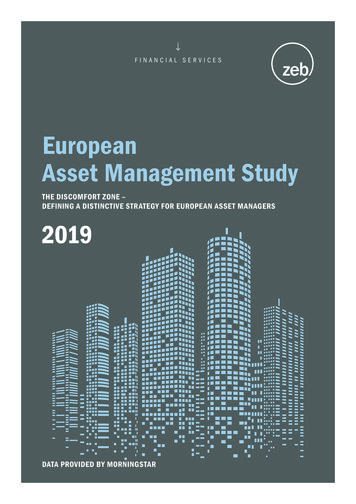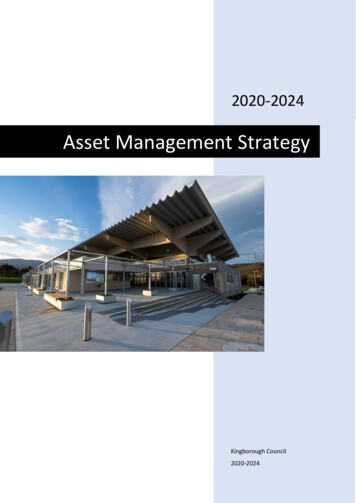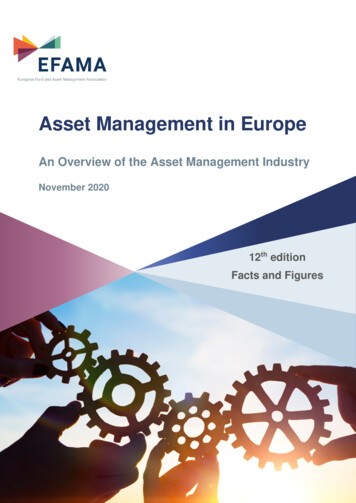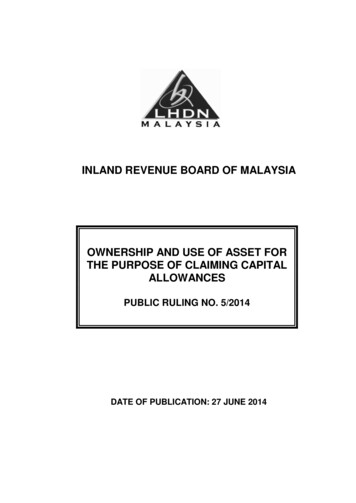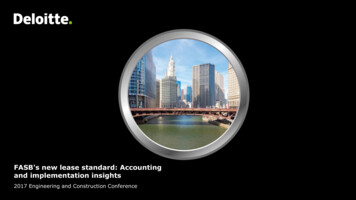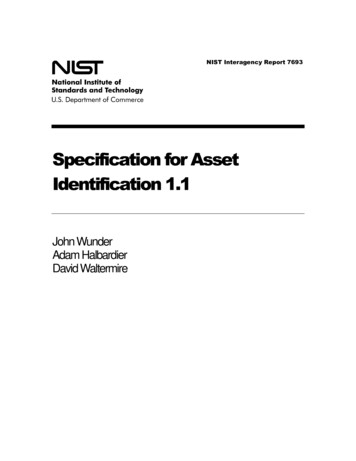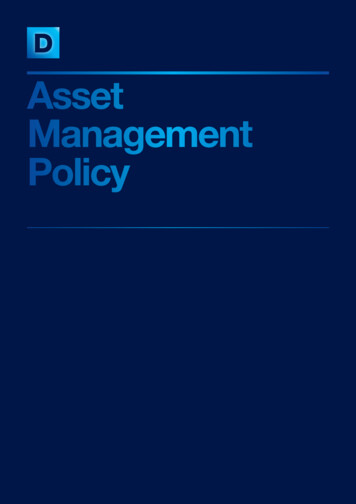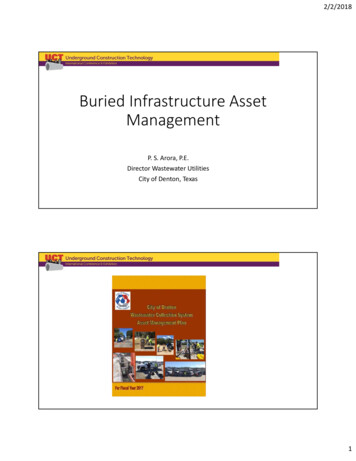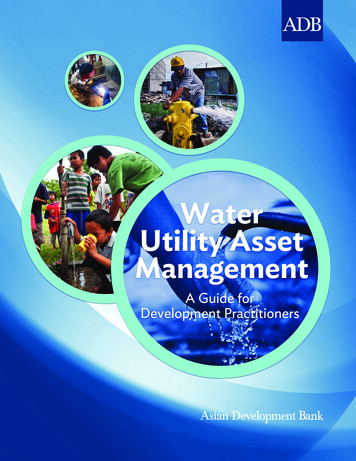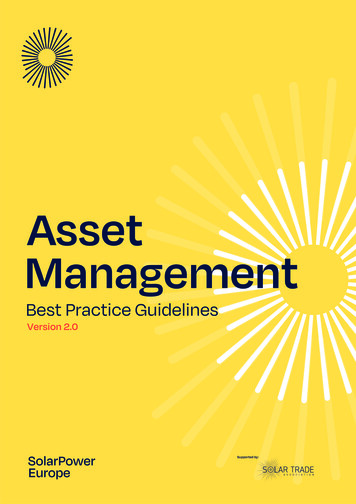
Transcription
AssetManagementBest Practice GuidelinesVersion 2.0Supported by:
DEMONSTRATE YOUREXCELLENCEwith the Solar Best Practices MarkWith at least 38.4 gigawatts (GW)of newly-installed solar photovoltaic(PV) capacity worldwide.Your BenefitsVerify your level ofexcellence using theinteractive checklistand follow best gthen your company’scredibility by offering accesson request to your checklistand technical dossier.Graphic toolkitGet listed in the CompaniesDirectory and display theSolar Best Practices Markon your website andpublications.Use the toolkit to make themost out of the Mark’s valuefor your company.visit solarbestpractices.comRegistration is free of charge for SolarPower Europe members.FEATURED SUPPORTERSThe Solar Best Practices Mark was createdand is powered by SolarPower Europe.SolarPower Europe – Leading the Energy TransitionSolarPower Europe is a member-led association that aims to ensure thatmore energy is generated by solar than any other energy source by 2030.www.solarpowereurope.org M. AgnorExcellence
ForewordWelcome to Version 2.0 of SolarPower Europe’s Asset Management Best Practice Guidelines. Building on asuccessful Version 1.0 published in December 2019, this update incorporates even more industry experience,delivering a forward-looking vision for the solar Asset Management segment.While Operation and Maintenance (O&M) service providers take care of the solar power plant on a technicallevel, Asset Managers are responsible for the commercial and financial management of a solar investment, andthe supervision and control of technical activities. They manage a company or portfolio rather than a powerplant, often across different geographies, dealing with a variety of regulatory frameworks and business models.Asset management is also defined as the coordinated activities of an organisation to generate value from itsassets (ISO 55000).With the professionalisation and globalisation of solar investors and investment portfolios, service qualityexpectations have risen steadily, putting increasing requirements on Asset Managers who are expected tocontinuously improve the return on investment via various processes, including revenue optimisation, costreduction, financial restructuring, contractual renegotiation, and technology adaptation. To achieve this, AssetManagers are expected to transition from simple tools, such as self-made spreadsheets, to advanced digital AssetManagement Platforms, which enable efficient and effective management of wide and diverse solar portfolios.SolarPower Europe published Version 1.0 of the Asset Management Best Practice Guidelines to support the solarindustry in achieving these goals. Version 2.0 aims to build on the success of the first edition by incorporatingeven more industry experience from two dozen leading solar experts, including Asset Managers as well as O&Mproviders, asset owners, technical advisors, digital solutions providers and more. Over the course of the past year,existing chapters of the first version have been extensively discussed, enhanced, and refined in the LifecycleQuality Workstream. Version 2.0 features a new, dedicated chapter on risk management in the operational phase,and a useful skills matrix for Asset Managers in the annex. Reflecting the latest market and technology trends,we have added several new sections in the existing chapters covering topics such as lifecycle best practices,value-added services, revamping & repowering, management of unsubsidised projects, challenges in multijurisdictional and global portfolios, data format and aggregation, and digital twins. Finally, we have also developedthe Asset Management Best Practice Mark, a voluntary quality label for Asset Management providers that comeswith a useful self-assessment checklist, available at www.solarbestpractices.com.This past year was a milestone for our Workstream on multiple fronts. The former “O&M Task Force” becamethe “Lifecycle Quality Workstream” to reflect its broadening scope, and the Workstream successfully developedthe Engineering, Procurement and Construction (EPC) Best Practice Guidelines; in the future we have theambition to develop best practices for more segments across the project lifecycle. The dissemination of bestpractices around the world has also continued: we published the French-language Tunisian edition of the O&MBest Practice Guidelines and we are working on Indian and African editions.We thank our members for their extraordinary engagement and support. We will continue the work in 2021 andinvite interested stakeholders to join us in our endeavour to develop and disseminate best practices across thesolar project lifecycle.ADELE ARAHead of GlobalBusiness Operations atLightsource bpChair of the LifecycleQuality WorkstreamPROF. DR. RALPHGOTTSCHALGDirector, Fraunhofer CSPVice-Chair of the LifecycleQuality WorkstreamAsset Management Best Practice Guidelines version 2.0ALDEN LEEHead of SolarProcurement, Logisticsand Quality,ABO WindWALBURGAHEMETSBERGERChief Executive Officer,SolarPower EuropeVice-Chair of the Lifecycle3
Chair of the SolarPower Europe Lifecycle Quality Workstream: Adele Ara, Lightsource bp.Vice-Chairs of the SolarPower Lifecycle Quality Workstream: Ralph Gottschalg, Fraunhofer CSP; Alden Lee, ABO Wind.Coordinator of the SolarPower Europe Lifecycle Quality Workstream: Máté Heisz, SolarPower Europe.Contact: info@solarpowereurope.org.Contributors of Version 2.0: Adele Ara, Lightsource bp; Walter Barbarotto, BayWa r.e.; Giuseppina Casanova, BayWa r.e.; Paolo V. Chiantore, BayWa r.e.; JuanFernandez, Sonnedix; Vincenzo Giorgio, Bird & Bird; Ralph Gottschalg, Fraunhofer CSP; Máté Heisz, SolarPower Europe; Grant Hilti, Heliospekt; Will Hitchcock,Above Surveying; Edmee Kelsey, 3megawatt; Thomas Lebreuilly, Akuo Energy; Etienne Lecompte, Powerhub; Alden Lee, ABO Wind; David Lewis, Akuo Energy;Pierpaolo Mastromarini, Bird & Bird; David Moser, Eurac Research; Esther Munoz, Iberdrola; Constantinos Peonides, Alectris; Martina Pianta, 3E; Eliane Pohl,Greenbyte; Ali Rahmati, Fronius; Pedro Rocha, Voltalia; Wolfgang Rosenberg, TCO Solar; Maria Sabella, Relight Energy Services; Thomas Sauer, EXXERGY; AleksisSchäfer, greentech; Claire Schön, Alteso; Elaine Teo, Heliospekt; Filipa Ximenes, Voltalia.Supported by: the Solar Trade Association (STA).Acknowledgements: SolarPower Europe would like to extend a special thanks to all members that contributed with their knowledge and experience to thisreport. This would never have been possible without their continuous support.Project Information: The SolarPower Europe O&M Task Force officially started its work in April 2015, and it became the Lifecycle Quality Workstream in 2020,to cover O&M, Asset Management and EPC. It operates through frequent exchanges and meetings. The Workstream’s flagship reports are the O&M Best PracticeGuidelines, the Asset Management Best Practice Guidelines and the EPC Best Practice Guidelines, which reflect the experience and views of a considerableshare of the European solar industry today. There has been no external funding or sponsorship for these reports.Disclaimer: This report has been prepared by SolarPower Europe. It is provided to recipients for general information only. Nothing in it should be interpreted asan offer or recommendation of any products, services or financial products. This report does not constitute technical, investment, legal, tax or any other advice.Recipients should consult with their own technical, financial, legal, tax or other advisors as needed. This report is based on sources believed to be accurate.However, SolarPower Europe does not warrant the accuracy or completeness of any information contained in this report. SolarPower Europe assumes noobligation to update any information contained herein. SolarPower Europe will not be held liable for any direct or indirect damage incurred by the use of theinformation provided and will not provide any indemnities.Design: Onehemisphere, Sweden.ISBN: 9789464073423.Published: November 2020.4Asset Management Best Practice Guidelines version 2.0
SolarPower Europe would like to thank the members of the LifecycleQuality Workstream that contributed to this report including:cast4allT E C H N O L O G I E SSponsor members of SolarPower Europe:Asset Management Best Practice Guidelines version 2.05
Table of contentsForeword3Table of contents6List of tables and figures8List of 2.1.2.3.Rationale, aim and scopeWhat is asset management?OverviewAsset management key targetsAsset management commitmentsand policies1.2.4. Value-added services1.2.5. Stakeholders and roles1.3.How to benefit from this document171820212Definitions223Lifecycle project management273.1.3.2.3.3.3.4.3.5.4Risk management in theoperational phase4.1.4.2.4.3.4.4.4.5.4.6.4.7.4.8.Definition of riskand risk managementFinancial risk factorsRegulatory and policy risk factorsContractual risk factorsTechnical risk factorsCommercial risksRisk transferSector reputational .6.7.6.8.6.9.6.10.6.11.6.12.Technical reportingSite visits and non-intrusiveinspectionsManagement of ancillaryservice providersInterface with local energyauthorities & regulatory complianceWarranty managementInsurance claimsContract management(operational contracts)Asset optimisation (technical)Revamping & repoweringEnvironmental managementHealth & safety managementChallenges of multi-jurisdictionaland global portfoliosCommercial and financialasset 1426.4.7Site data and informationDocuments acquisitionand managementSystem and toolsTechnical asset management6.3.12131316The key stages of a project27Overview of the role of asset managerthrough the lifecycle of the project 27Core competencies needed forlifecycle project management28Activities at key stages29Lifecyle lessons learntand feedback loop31385.3.6Executive summaryHandover of solar assetsFinancial reportingStrategy managementManagement of unsubsidisedprojectsCorporate administrative servicesAccountingCustomer relationshipAccounting assistanceInvoicing/billing and paymentsRevenue ControlCash flow managementWorking capital reconciliationFinancial controlContract management(financial contracts)Suppliers account managementSupplier penalties invoicingInterface with banks and investorsEquity/debt financing managementTax preparation, filingand administrationChallenges of multi-jurisdictionaland global 5757585858586262636364Asset Management Best Practice Guidelines version 2.0
Table of in supplier requirementsSupplier selection and evaluationFurther considerations to be takeninto account in the selection processSupply account controlSupply chain controlPeople and skills10 Data management andhigh-level monitoring10.1.7375Asset ManagementPlatform functionalities7610.1.1. Reporting7610.1.2. Site construction due diligence7810.1.3. Optimisation of energy production 7810.1.4. Regular updates and software reliability 7810.1.5. Lifecycle data collection7810.1.6. Operational risk management7910.1.7. Procurement process management 7910.1.8. Deadlines management7910.1.9. Health & safety records7910.1.10.Incidents records7910.2. Types of data collected throughthe Asset Management Platform7910.2.1. Technical data8010.2.2. Operational data8010.2.3. Financial & commercial data8010.2.4. Contractual & regulatory data8010.2.5. Third-party data8110.3. Data format8110.4. Aggregating data8110.5. Interoperability8210.6. Cybersecurity8210.7. Data portability, backup anddisaster recovery8410.8. Handover of data and documents85Asset Management Best Practice Guidelines version 2.011 Key Performance IndicatorsAsset manager experienceQuality of service based onperiodic asset owner surveysReports Compliance Rate (RCR)Invoicing Compliance Rate (ICR)Contracts Optimisation Rate (COR)Requests treatedTimely Response Rate (TRR)Quality of the tender procesO&M contractor compliance12 Contractual frameworkScope of the assetmanagement contract12.2. Asset management contract fee12.3. Contractual guarantees12.4. Service standards12.5. Limitation on authority12.6. Responsibility and accountability12.7. Subcontracting12.8. Reporting12.9. Continuity of operationand termination12.10. Force Majeure12.11. Direct agreement12.12. 9191919191Annex A92References937
List of tablesList of figuresTable 1:Key stages of project lifecycle28Table 2:Definition of risk32Table 3:Financial risk factors34Table 4:Regulatory risk factors34Table 5:Technical risk factors35Table 6:Commercial risks36Table 7:Risk transfer37Table 8:Key categories of site informationto be collected by incomingasset managerTable 9:Key documents to be collected aspart of a project handoverTable 10: Proposed indicators/values requiredfor the reportingTable 11:Definition of revampingand repowering39404349Disciplines to be mastered by assetmanagement service providers14Figure 2: Roles and responsibilities by differentstakeholders in the field of assetmanagement and O&M15Figure 3: Steps to agree strategic approach toincreased profitability16Figure 4: Drivers of operational assetmanagement services17Figure 5: Integrated approach to maximiserisk-adjusted returns18Figure 6: Example of handover documentationand process at the start of theconstruction phase30Figure 7:Lesson learnt and feedbackloop process31Figure 8: Risk management strategy chart33Figure 9: Insurance solutions oriented to thepurpose of insurance37Table 12: Technical asset management:challenges of multi-jurisdictionaland global portfolios51Table 13: Commercial and fInancial assetmanagement: challenges of multijurisdictional and global portfoliosFigure 10: New requirements driven by new riskallocation and critical importance ofdata management5464Table 14: Key criteria for the selection ofthe various suppliersFigure 11: Kraljic matrix of main suppliers involvedin solar power plant operation6669Table 15: Key performance indicators forrelevant suppliers71Figure 12: Overview of the analytical hierarchyprocess methodology – analysisproduced for each supplier68Figure 13: Management of concentration risks70Figure 14: Traditional linear asset managementapproach and asset-centricinformation-based approachwith three key stakeholders ofasset management77Figure 15: Types of data collected alongthe lifecycle of the project78Figure 16: Scope of the assetmanagement contract90Table 16: Supply chain risks andmitigation measures72Table 17: Frequency of key data provision77Table 18: Examples of data integration options 82Table 19: Data backup minimum requirementsand best practices858Figure 1:Asset Management Best Practice Guidelines version 2.0
List of ting currentAnalytical Hierarchy ProcessAsset ManagementAnnual Maintenance PlanAutomatic Meter ReadingAnnual Maintenance ScheduleApplication Programming InterfaceComputer-aided designClosed Circuit TelevisionComputerised MaintenanceManagement SystemCOD Commercial Operation DateCSMS Cybersecurity Management SystemDCDirect CurrentDMS Document Management SystemDORDivision of ResponsibilityDSCR Debt Service Coverage RatioDSLDigital Subscriber LineEH&S Environment, Health and SafetyEMSEnergy Management SystemEPCEngineering, Procurement, ConstructionEPIEnergy Performance IndexERPEnterprise Resource Planning SystemESSEnergy Storage SystemFACFinal Acceptance CertificateFITFeed-in TariffFTPFile Transfer ProtocolGPRS General Packet Radio ServiceH&SHealth and SafetyHVHigh VoltageIECInternational Electrotechnical CommissionIGBT Insulated-Gate Bipolar TransistorsIPPIndependent Power ProducerIRInfraredAsset Management Best Practice Guidelines version CUPSInternational Renewable Energy AgencyKey Performance Indicatorkilowattkilowatt-hourkilowatt-peakLocal Area NetworkLevelised Cost of ElectricityLong Term Evolution, category M1Long-power Wide-area NetworkLow VoltageMean Absolute ErrorMinimum Irradiance ThresholdMaximum Power Point TrackingMedium VoltageMegawattOperation and MaintenanceOriginal Equipment ManufacturerOperating SystemProvisional Acceptance CertificatePlane of ArrayPower Purchase AgreementPersonal Protective EquipmentPerformance RatioPhotovoltaicRoot Mean Square ErrorReturn on InvestmentRemotely Piloted Aircraft System (drone)Supervisory Control And Data AcquisitionService-level AgreementSpecial Purpose VehicleStandard Test Conditions (1000 W/m2, 25 C)Uninterruptible Power Supply9
Executive summaryWith the professionalisation and globalisation of solarinvestors and investment portfolios and servicequality expectations rising steadily there areincreasing requirements of Asset Managers. Expectedto continuously improve the return on investment viavarious processes including revenue optimisation,cost reduction, financial restructuring, contractualrenegotiation and technology adaptation, AssetManagers are relying increasingly on advanced digitalplatforms. The latter enable efficient and effectivemanagement of wide and diverse solar portfolios. Thepresent Guidelines are intended for Asset Managersas well as for investors, asset owners, financers,software solutions providers, O&M contractors,technical consultants, and all stakeholders in Europeand beyond interested in improving solar AssetManagement services.This document starts by contextualising AssetManagement, defining the roles and responsibilities ofvarious stakeholders such as the Asset Manager, theOperations Service Provider and the MaintenanceProvider and presenting an overview of technical andcontractual terms to achieve a commonunderstanding of the subject. It then walks the readerthrough the different business areas and other keyactivities of solar Asset Management, identifying foreach segment “minimum requirements”, “bestpractices” and “recommendations”.Risk management in the operational phaseThis chapter focuses on the risks emerging from thecommercial operation date (COD), under theoperational phase. It defines the terms risk (“effect ofuncertainty on objectives”) and risk management (riskavoidance, risk reduction, risk control, risk transfer,residual risk) and gives an overview of financial,regulatory, contractual, technical, commercial andsector reputational risk factors.Handover of solar assetsThe journey of an Asset Manager starts with ahandover (or on-boarding) process. This chapteraddresses the importance of the handover processwhen an operational asset is transferred from an AssetManager to another or when an asset owner decidesto internalise the AM services. It presents thecategories of site information and data to be handedover (such as real estate, power plant design andconstruction, production data, EPC and O&Mcontractor information), as well as the key documentsto be collected and reviewed in the on-boardingprocess (such as the O&M manual, permits, contractsin place, warranties etc). It also underlines theimportance of interoperability and compatibilitybetween systems in case data needs to be migrated.Technical asset managementLifecycle project managementAsset Managers can be involved in all phases of thesolar power plant’s lifecycle: from developmentthrough Engineering, Procurement and Construction(EPC) and Operation and Maintenance (O&M) todecommissioning and disposal. The documentfocuses largely on Asset Management during theoperational phase – the longest phase of the projectlifecycle – but this chapter presents an overview oflifecycle Asset Management with roles and tasks in allproject phases. Key competencies related to lifecycleAsset Management include stage-gate management,documentation management, lifecycle riskmanagement and warranty management (in relationto the EPC warranty). Being involved along the lifecycleof the projects represents also a significant learningopportunity from a technical, contractual and financialperspective (feedback loop).10Technical Asset Management (TAM) encompassessupport activities to ensure the best operation of asolar power plant or a portfolio (i.e. to maximiseenergy production, minimise downtime and reducecosts). In many cases, the O&M contractor assumessome technical Asset Management tasks such asplanning and reporting on Key Performance Indicators(KPIs) to the asset owner. However, in cases where theTechnical Asset Manager and the O&M contractor areseparate entities, close coordination and informationsharing between the two is indispensable. TAM alsoincludes ensuring that the operation of the PV plantcomplies with national and local regulations andcontracts, and advising the asset owner on technicalasset optimisation via, for instance, repoweringinvestments.Asset Management Best Practice Guidelines version 2.0
Commercial and financial asset managementData management and high-level monitoringCommercial and Financial Asset Managementencompasses support activities for the best operationof a business, including accounting, cash flowmanagement, contract management, equity/debtfinancing management, tax management, as well asliaising with key stakeholders such as investors andbanks. Financial reporting is an important componentof Commercial and Financial Asset Management andinvolves regularly providing the asset owner withfinancial statements, capital structure analyses,profitability analyses, cash flow and debt complianceoverviews. Financial asset optimisation activities thatshould be performed by Asset Managers include costreduction, financial restructuring and contractualrenegotiation.Asset Managers should rely on a specialised AssetManagement Platform to store, manage and, ideally,analyse technical and non-technical data andinformation collected from and relating to the solarasset, portfolio or SPV. Such a platform makes itpossible for the solar industry to transition to an assetcentric information-based management approach,which addresses three key challenges: (1) loss ofgeneration and income; (2) loss of time; and (3) lackof transparency, which is in contrast to the traditionallinear Asset Management approach, whereinformation flows from the asset through the O&Mcontractor to the Asset Manager and ultimately to theasset owner, with relatively little delving into the dataand information extracted.ProcurementKey performance indicatorsProcurement involves identifying and selecting keysuppliers involved in the operation of the solarbusinesses and solar power plants, such as O&Mcontractors, insurance and IT solutions providers,security service contractors and in some casesproviders of ancillary services such as electricity, panelcleaning and vegetation control. The Asset Managershould identify the right trade-off between price,quality of services and key contractual terms andconstantly balance them in line with marketconditions. For example, in order to evaluate andselect O&M contractors, Asset Managers arerecommended to use SolarPower Europe’s O&M bestpractices checklist, which can be downloaded fromwww.solarbestpractices.com.A close monitoring of Asset Management proceduresis required to ensure implementation effectiveness.This can be achieved through the definition of clearand objective Key Performance Indicators (KPIs),which need to be continuously assessed. KPIs usedto measure Asset Management service qualityinclude Reports Compliance Rate, InvoicingCompliance Rate, Contracts Optimisation Rate,Requests Treated and Timely Response Rate. Ingeneral, one of the most important indicators is thetrack record of the Asset Manager.People and skillsIt is important that all personnel from Asset Managementcompanies have the relevant experience andqualifications necessary to perform the work in a safe,responsible and accountable manner. The annex of theseGuidelines contain a useful skills matrix for technical,commercial and financial Asset Management.Asset Management Best Practice Guidelines version 2.0Contractual frameworkThe scope of a full-service Asset Managementagreement corresponds to the structure of thisdocument, with the main business areas beingTechnical, Commercial and Financial AssetManagement, and procurement and lifecycle projectmanagement. Asset managers do not provide anycontractual guarantees comparable to the “availabilityguarantee” provided by O&M contractors, however theAsset Manager is obliged to provide the services inaccordance with all laws, authorisations, good industrypractices and current market standards.11
1Introduction Shutterstock1.1. Rationale, aim, and scopeA professional and dedicated Asset Management (AM)service package ensures that photovoltaic (PV) plants,individually and as part of a wider portfolio, achievetheir maximum potential from both technical andfinancial perspectives.Owners, investors and lenders in the solar PV industryhave increasingly acknowledged that AM services arenot limited to basic day-to-day administrative tasks. IInstead, the role of a competent and multidisciplinaryAM service provider is crucial to minimisingoperational and interface risk whilst maximising thereturn on investment of solar PV assets.Asset managers can be involved in all phases of thesolar power plant’s lifecycle from development todecommissioning, however these Guidelines focus onAM during operation – the longest phase of the projectlifecycle. (For more information on lifecycle projectmanagement, see Chapter 3.) Development (typically 1-3 years) Construction (a few months, size-dependent) Operation (typically 30 years) Decommissioning and disposal (a few months)The in-depth knowledge of the assets developed duringthe operational phase of the PV lifecycle puts AssetManagers in a key position to influence theperformance of the sites and their longevity. AssetManagers also provide vital feedback to thestakeholders involved in development and constructionwith the aim of optimising further the ROI of solarinvestments from the earliest stages of the lifecycle.12Although the solar PV industry is still developing, italready presents a wide range of well-establishedpractices and approaches for Asset Management. Thisfacilitates the creation of innovation niches forexample in the field of digitalisation, however it alsogenerates the lack of clarity as to what is a widelyacceptable level of AM service fulfilling the mainrequirements of stakeholders, specifically owners,investors, lenders and other funding authorities, as wellas local communities.While a variety of international technical standardshave been developed, the current level ofstandardization in AM remains insufficient. The typicalAM scope of work varies significantly, and so does theuse of advanced digital tools, both of which aspectsare important factors in determining the efficiencyand effectiveness of AM services.The aim of these Guidelines is to identify therequirements for high quality AM services andpromote best industry practices. The importance ofAsset Management grows steadily, as the industryfinds itself at an inflection point with subsidiescontinuously being reduced and subsidy-free PVassets requiring even tighter management to ensurethat owners and investors meet their objectives.In line with SolarPower Europe’s Operation &Maintenance (O&M) Best Practice Guidelines, thevalue proposition of this report is its industry-lednature, gathering the knowledge and experience ofwell-established and leading companies in the field ofproject development and construction (EPC), AssetManagement, O&M, utilities, manufacturers andmonitoring tool providers. The scope of the currentAsset Management Best Practice Guidelines version 2.0
edition includes the utility scale segment and morespecifically, systems above 1MW. The Guidelines arebased on the experience of companies operatingglobally (with a concentration in Europe), and identifyhigh-level requirements that can be applied worldwidefor the most performant AM services. Specificnational considerations such as legal requirements arenot included and should therefore be consideredseparately if the Guidelines are to be used in specificcountries. The Guidelines refer to AM services asprovided by a third-party service contractor differences in approach between third-party and inhouse AM are highlighted where materially relevant.The content covers technical and non-technicalrequirements, classifying them when possible intothe following:1. Minimum requirements, below which the AMservice is considered as poor or insufficient, andwhich form a minimum quality threshold for aprofessional and bankable service provider;2. Best practices, which are methods considered stateof-the-art, producing optimal results by balancingthe technical as well as the financial side;3. Recommendations, which can add to the qualityof the service, but whose implementation dependson the considerations of the asset owner, such asthe available budget.As for the terminology used in this document todifferentiate between these three categories, verbssuch as “should” indicate minimum requirements,unless specified explicitly otherwise, as in, “should, asa best practice”.1.2. What is asset management?1.2.1. OverviewOver the past 30 years, Asset Management (AM) hasevolved to become a standalone discipline. The PAS55 (“Specification for the optimised management ofphysical assets”), published in 2004 by the BritishStandards Institution, was the first attempt atclarifying and standardising the meaning of physicalAM systems. Industries such as mining,manufacturing, utilities and transport widely adoptedPAS 55 and as a result the standard was accepted asa platform to develop the ISO 55000 series ofinternational standards on “Asset Management” thatAsset Management Best Pra
with the Solar Best Practices Mark. 2220 SPE Asset Management Guidelines 2.0 05 mr.pdf 2220 SPE Asset Management Guidelines 2.0 05 mr.pdf . Asset Management Best Practice Guidelines version 2.0. 5. Handover of solar assets 38 5.1. Site data and information 38
